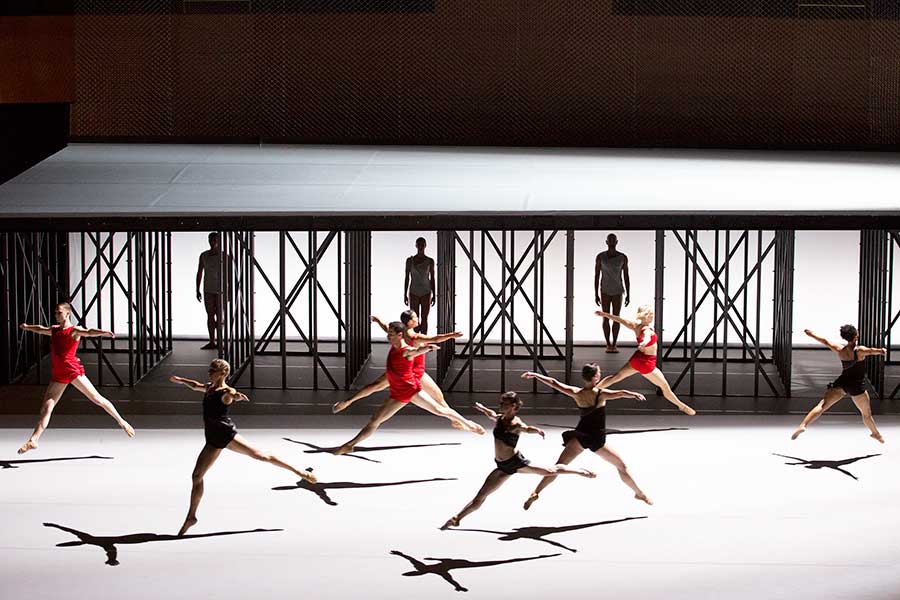When this year’s Fringe Festival unfurls, its stateliest show — a get for festival honchos — is “Available Light,” a movement work created by choreographer Lucinda Childs, composer John Adams and architect Frank Gehry. Originally performed in 1983, the nearly hour-long work explores open space as it interacts with music and motion without fixed focus in its dance or rhythm. Everything seems to float in open air as its variously grouped and toned dancers — some on separate levels — exist geometrically, a Childs signature. This is what Childs has done since she created the epic choreography for Phillip Glass and Robert Wilson’s legendary “Einstein on the Beach” in 1976 and, later, Wilson and Glass’ opera “White Raven.”
“Collaboration is what changed for me going forward after ‘Einstein,’” Childs said. “It’s always been part of dance’s tradition, to have a choreographer work directly with a contemporary — be it a musical/compositional, a visual artist or a set designer.”
The legendary minimalist and ultimately post-modern choreographer with nearly 40 works for major ballet companies (along with her own) has had many notable partnerships and collaborations in her life. She studied with the likes of Merce Cunningham and was part of the Judson Dance Theater. She had a well-known, loving relationship with writer/theorist Susan Sontag. She choreographed John Adams’ 21st-century opera “Doctor Atomic” and worked with Mikhail Baryshnikov’s White Oak Dance Company. Yet for an artist who speaks with such focus about her skills as a team player (“no one move or dancer is more important than the other,” she said of her work), Childs is an iconoclast.
PGN: Are you a person who hangs onto things from the past?
LC: I never expected to. When we revived certain dances like those in “Einstein,” we never thought they would become part of any repertoire. It all just happened. When you make a work such as “Available Light,” where you’re not certain that it could ever be done again, you learn that you have to be somewhat willing to let things go. All of it is so intangible. You can’t put these things in museums. The only way to demonstrate these things in the present is to demonstrate them.
PGN: Some choreographers stay in their own lane; you created your own. Were you always comfortable being who you were and doing what you were doing?
LC: No. I think I started out lucky but youthful with the Judson Group and people who were part of the Cunningham school and company. I couldn’t think, still can’t, of a better way to start. You can try adventurous things and succeed and fail in good company. It was all a very encouraging time for me.
PGN: How did “Available Light” come about in 1983?
LC: It really just stemmed from the commission from the Museum of Contemporary Art in Los Angeles, which was unusual at that time. They saw “Dance” and “Einstein” and proposed that I — the New Yorker — come and work with Gehry and Adams, both on the West Coast. “Light” was the subject of the conversation from the start.
PGN: Adams’ music does not have discernible rhythm. How do you face that?
LC: We create our own; it’s important, as we are very concerned with precise beginnings and ending. We have to know exactly where we are within the music and that must be consistent every time that we perform — that is something that Cunningham had to do with John Cage: Create and maintain one’s own pulse.
PGN: Which relates directly to the geometry of everything you do …
LC: I deal with spatial relationships and charge the space symmetrically. It’s important to know where a dancer is located in a space.
PGN: Especially when paired with light.
LC: Geometry is just a tool in which I can present the variations — movement material that is quite simple. What is complex is what I do with it, how it is treated. Some people look at it and their opinion is we’re doing the same thing over and over [laughs]. Anybody can do that, but there is something very demanding and complex in all that repetition. It takes enormous concentration to repeat oneself.
“Available Light” runs Sept. 10-12 at Drexel University Armory, 32nd and Cuthbert streets. For more information or tickets, visit http://fringearts.com/event/available-light/.
